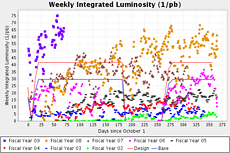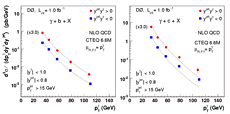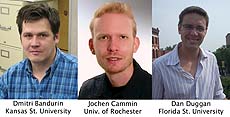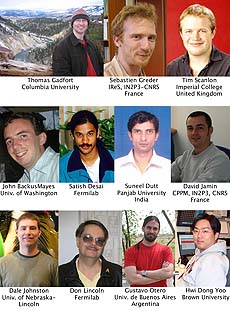|
Thursday, Dec. 11
1 p.m.
Physics and Detector Seminar - West Wing, WH-10NW
Speaker: Jeff Gronberg, Lawrence Livermore National Laboratory
Title: Gamma-Gamma Physics and Detectors at the ILC
2:30 p.m.
Theoretical Physics Seminar - Curia II
Speaker: Puneet Batra, Columbia University
Title: Supersymmetric Electroweak Symmetry Breaking
3:30 p.m.
DIRECTOR'S COFFEE BREAK - 2nd Flr X-over
4 p.m.
Special Joint Experimental-Theoretical Physics Seminar (NOTE DATE) - One West
Speaker: Georgia Karagiorgi, Massachusetts Institute of Technology
Title: Electron Antineutrino Appearance Results from MiniBooNE
Friday, Dec. 12
2:30 p.m.
Special Particle Astrophysics Seminar (NOTE DATE) - Curia II
Speaker: Daniel Feldman, North Eastern University
Title: Connecting Dark Matter and the LHC in the Dual Probes of Physics Beyond the Standard Model
3:30 p.m.
DIRECTOR'S COFFEE BREAK - 2nd Flr X-Over
4 p.m.
Joint Experimental-Theoretical Physics Seminar - One West
Speaker: Shabnam Jabeen, Boston University
Title: The Top Quark as a Window to New Physics at D0
Click here for NALCAL,
a weekly calendar with links to additional information. |
|
Thursday, Dec. 11
- Minnesota wild rice w/chicken
- Tuna melt on nine grain
- Smart Cuisine: Italian meatloaf
- Chicken casserole
- Smart Cuisine: vegetarian salad wrap
- Assorted sliced pizza
- Mandarin chicken
Wilson Hall Cafe menu |
|
Thursday, Dec. 11
Dinner
- Shrimp cocktail
- Beef Wellington
- Garlic smashed potatoes
- Sautéed spinach
- Chocolate cups with raspberry mousse
Wednesdsay, Dec. 17
Lunch
- Tortellini with Shrimp, Red Peppers, Green Onions and Pine Nuts
- Spinach & Pomegranate Salad
- Peppermint Cheesecake
Chez Leon menu
Call x3524 to make your reservation. |
|
|
Another record! Tevatron again surpasses expectations

The purple dots show that the Tevatron's performance in FY2009 has exceeded the federal goal, shown by the top line. The lower line shows the minimum acceptable luminosity range for FY2009. The weeks without lines coincide with scheduled maintenance shutdowns.
When Mary Convery moved to the Accelerator Division about 1 ½ years ago, people told her that with major upgrades finished there wasn't much to do but to keep the nearly three-decades-old Tevatron particle accelerator running smoothly.
"‘There are no more home runs to get,' I was told," said Convery, Fermi National Accelerator Laboratory deputy run coordinator. "Yet, we keep continuing to make improvements."
In the past five years at the Tevatron, the luminosity - the number of collisions per second - has increased sixfold. In the last six weeks alone, overall luminosity has improved 10 percent, generating more than a dozen luminosity records, sometimes multiple records in one week. Since October, the Tevatron has had nine of the top 10 stores in its history.
The Tevatron consistently tops past integrated luminosity records even without increasing the number of protons and antiprotons injected into the accelerator ring.
The higher the luminosity, the better the chance for discovery -- including sighting the Higgs boson, theorized to impart mass to other particles.
The Tevatron is on track to beat the FY 2009 estimated maximum weekly integrated luminosity by 20 to 25 percent. Earlier this month, the machine showed its stamina with a run of 15 uninterrupted stores. Achieving a run of more than six stores without interruption is considered good.
"So we are getting more bang for the buck," said Cons Gattuso, run coordinator.
Read more
-- Tona Kunz
|
Obama pick as energy secretary says new energy sources, stopping climate change are essential
From Chicago Tribune,
Dec. 11, 2008
Steven Chu, the Nobel Prize-winning physicist who is President-elect Barack Obama's choice for energy secretary, has been a vocal advocate for more research into alternative energy, arguing that a shift away from fossil fuels is essential to combat global warming.
Chu, a Chinese-American who currently is director of the Lawrence Berkeley National Laboratory in California, has in recent years campaigned to bring together a cross-section of scientific disciplines to find ways to counter climate change.
If action is not taken now to stop global warming, it may be too late, he argues.
Since 2004, Chu has been director of the Berkeley lab, the oldest of the Energy Department's national laboratories, with its 4,000 employees and a budget of $650 million. The laboratory does only unclassified work and under Chu has been a center of research into biofuels and solar energy technologies. He is a former head of the physics department at Stanford University.
Read more
|
Regulation change for 403 (b) plans
The Internal Revenue Service has finalized regulations covering the 403(b) plans. All employees will receive a memo explaining in detail the changes to the eligibility requirements for obtaining hardship withdrawal distributions. You can access the memo on the Benefits Web site.
|
High Energy Physics Team Sets New Data-Transfer World Records
From Caltech Center for Advanced Computing Research news room,
Dec. 8, 2008
Building on seven years of record-breaking developments, an international team of physicists, computer scientists, and network engineers led by the California Institute of Technology (Caltech)-with partners from Michigan, Florida, Tennessee, Fermilab, Brookhaven, CERN, Brazil, Pakistan, Korea, and Estonia-set new records for sustained data transfer among storage systems during the SuperComputing 2008 (SC08) conference recently held in Austin, Texas.
Read more
|
|
|
Fishing the heavy seas

This figure shows the production rate for photons in association with a bottom quark (left) and a charm quark (right) as a function of photon transverse momentum and for two angular relationships of the photon and quark. The measured results (red & blue dots) are compared with QCD theory predictions. While the photon + bottom quark results agree with theory, the photon + charm quark results disagree for larger photon momentum.
To many people, the proton does not carry an air of mystery. Everything we see, smell, touch and taste contains protons. Scientists have known of the proton’s existence since its discovery by Ernest Rutherford in 1918. Physicists, however, see the proton as a complex object.
Since physicists have begun exploring the interior of the proton, they have found themselves adrift in uncharted waters. Scientists have learned that the proton is made of three quarks, but inside the proton they also observed a roiling and frothing sea of “virtual” particles that splash in and out of existence. This proton sea, awash with both massless gluons and massive quarks, is responsible for such fundamental proton properties as mass and internal structure.
Physicists from the DZero experiment have recently concluded an expedition into the proton, fishing for the heaviest quarks swimming deep in the proton's sea.
Theories based on quantum chromodynamics (QCD) can predict the properties of the proton sea. But the great difference in masses of the different quarks creates a complication. The heaviest quarks, such as bottom and charm, should have a harder time popping into existence, while the lighter quarks, such as up, down and strange, should be more prevalent. Therefore, predictions describing the heaviest quarks within the proton sea are extremely hard to test due to the relative scarcity of these heavy quarks.
DZero physicists have proposed to probe these hefty denizens of the deep using the Tevatron's proton-antiproton collisions. Using photons produced along with heavy quarks, scientists can attempt to chart the proton's sea. By testing the QCD predictions for this signature, DZero's researchers can provide an invaluable test that can improve searches for new physics at both the Tevatron and the LHC.
Using one inverse femtobarn of data, DZero scientists studied proton-antiproton collisions that produced a high-energy photon. Using algorithms to identify charm and bottom quarks, they focused on events with the signature of a heavy-flavor quark. Their results indicate that modern QCD calculations reliably predict the rate and relative behavior of particles in events that include bottom quarks. However, in events with charm quarks, the researchers observed a deviation from the QCD prediction. This is the first measurement of this type at the Tevatron, and it provides an indication that theories may need to be modified. With nearly five times more data recorded at DZero, these researchers will continue casting about for heavy quarks in the proton sea, improving our understanding of this mysterious particle.
Read more

A team of DZero physicists made primary contributions to this result. Not pictured: Michael Begel of Brookhaven National Laboratory.
 |
DZero's heavy-flavor quark identification team produces and maintains the algorithms used to identify bottom and charm quarks. Its efforts are necessary for a large range of physics analyses, including top measurements, Higgs searches and the analysis shown here. |
|
|